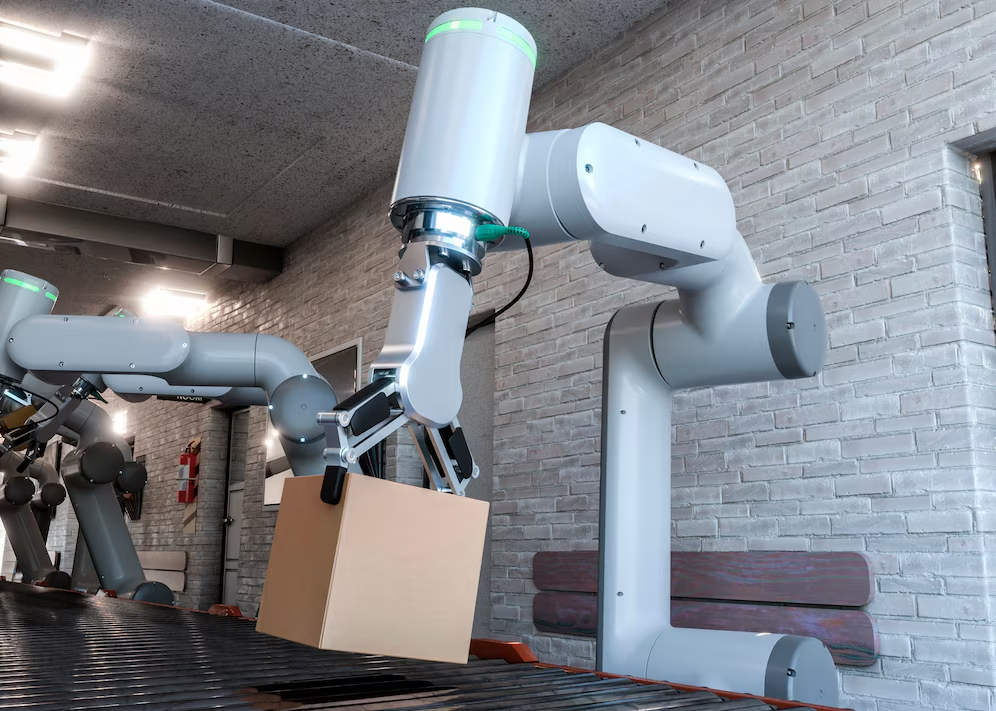Introduction to Automation with AI
L'automation with artificial intelligence (AI) has become an essential pillar for modern companies seeking to improve their productivity and optimize their operations. This revolutionary technology enables companies to delegate repetitive, time-consuming tasks to intelligent systems, freeing up human resources for higher value-added activities.


In a constantly changing business environment, theautomation with AI offers an effective solution for maintaining competitiveness. By integrating sophisticated algorithms and machine learning models, companies can not only reduce human error, but also anticipate market trends and make informed decisions. The impact of automation extends to various sectors, from web development to digital marketing, where it plays a crucial role in improving the customer experience.
The subject of automation with AI has become unavoidable in the business world, as it promises significant gains in productivity and efficiency. By harnessing the power of AI, companies can not only automate complex processes but also personalize interactions with their customers, delivering an enhanced user experience.
In the following sections of this blog post, we'll explore in detail the five key benefits of automation with AI for businesses. We'll look at how this technology can transform day-to-day operations, improve customer satisfaction, and open up new opportunities for growth. Get ready to discover how AI can become a strategic asset in your journey towards operational excellence.
Time-saving and efficient
Automation with AI represents a significant step forward for companies seeking to improve productivity and optimize efficiency. Automation enables repetitive, time-consuming tasks to be delegated to intelligent systems, freeing up employees for higher value-added tasks. For example, e-mail management, diary organization and data processing can be automated, considerably reducing the time needed to complete these tasks.
Automation tools such as chatbots, customer relationship management (CRM) software and human resource management (HRM) systems use AI to execute complex processes with greater accuracy and speed. For example, an AI-enabled CRM can analyze customer interactions and automate personalized responses, improving not only efficiency but also the customer experience. By automating data collection and analysis, companies can also make more informed decisions more quickly.
In addition, platforms such as UiPath and Blue Prism offer robust solutions for robotic process automation (RPA). These technologies automate administrative tasks such as data entry, report generation and inventory management. By using these tools, companies can reduce human error, improve process consistency and accelerate production cycles.
The integration of AI into automation processes is not limited to administrative tasks. It also extends to industrial operations, where automated robots can take over repetitive physical tasks, increasing safety and productivity on production lines. In short, automation with AI enables companies to maximize their operational efficiency, offering a significant competitive advantage in an increasingly demanding market.
-
Discount code HOSTINGER
Original price was: 11,99 €.2,99 €Current price is: 2,99 €. -
Divi Essential: The Ultimate Pack for Customizing Your Divi Site
Original price was: 150,00 €.5,00 €Current price is: 5,00 €. -
Elementor pro
Original price was: 399,00 €.10,00 €Current price is: 10,00 €. -
Imagify : Share Infinite 1 years
Original price was: 119,00 €.10,00 €Current price is: 10,00 €. -
Payment - 200 EUR
200,00 € -
Rank Math Pro
Original price was: 69,00 €.4,99 €Current price is: 4,99 €. -
Rank Math SEO : French translation file
Original price was: 10,00 €.0,00 €Current price is: 0,00 €. -
VidoRev 2.9.9.9.9.9.4 ultimate WordPress theme
Original price was: 57,00 €.5,00 €Current price is: 5,00 €. -
Wp rocket 5-year GPL license
Original price was: 300,00 €.7,80 €Current price is: 7,80 €.
Reducing Human Error
In the business world, human error can have costly consequences. According to a recent study, human errors account for almost 23% of financial losses in companies. Repetitive, manual tasks are particularly prone to these errors, which can lead to delays, data inconsistencies and lost productivity. This is where AI-powered business process automation comes in, offering a robust solution to minimize these errors.
Automation, by delegating repetitive tasks to intelligent systems, significantly reduces the risk of human error. For example, a financial services company that integrated AI systems into its transaction verification processes saw a 70% reduction in processing errors. These systems use sophisticated algorithms to detect and correct anomalies before they become problematic.
Another case study is that of a logistics company that has adopted automation for inventory management. Using intelligent sensors and AI software, they were able to reduce stock tracking errors by 50%, improving supply chain accuracy and efficiency. These examples clearly show that automation, in addition to improving productivity, plays a crucial role in reducing human error.
Testimonials from companies that have switched to automation bear witness to this. A project manager at a major technology company said, "Since we integrated automation into our processes, we have not only reduced errors, but also freed up our employees for more strategic tasks." This kind of feedback underlines the positive impact of automation on efficiency and customer experience.
Ultimately, integrating AI into business processes not only reduces human error, but also improves the overall quality of operations. Reducing errors translates into substantial cost savings and improved service reliability, boosting companies' competitiveness in the marketplace.
Productivity improvement
Automation, particularly when powered by artificial intelligence (AI), plays a crucial role in improving productivity within companies. Companies that integrate these technologies into their day-to-day processes are seeing substantial gains in performance and efficiency. By comparing automated and non-automated work environments, we can clearly observe significant differences in the results obtained.
To illustrate this impact, let's look at the cases of agencies A and B. Agency A has adopted an AI-based automation strategy, while Agency B continues to operate with traditional methods. The data collected show that Agency A has been able to reduce the time needed to complete repetitive administrative tasks by 30%. As a result, Agency A employees were able to devote more time to high-value activities, such as development strategy and customer engagement.
The graphs below highlight these differences. The first graph shows the average time spent on administrative tasks before and after the integration of automation at Agency A, while the second compares the productivity rates of the two agencies over a six-month period.
Figure 1: Average time spent on administrative tasks
Before automation: 50 hours/week
After automation: 35 hours/week
Graph 2: Six-month productivity rate
Agency A (automated): +40%
Agency B (non-automated): +10%
These data show that Agency A has not only improved its operational efficiency, but has also enabled its employees to focus on more complex and rewarding tasks. By reducing the time spent on repetitive tasks, automation contributes directly to increased productivity and a better employee experience. This is a concrete example of how the integration of AI and automation can transform a company's performance.
Enhanced Customer Experience
Automation with AI plays a crucial role in improving the customer experience, offering innovative solutions that meet consumers' needs faster and more accurately. Chatbots, for example, are capable of handling a multitude of queries in real time, providing instant and efficient responses to customers. Thanks to machine learning, these virtual assistants can understand and answer complex questions, offer relevant solutions and even learn from each interaction to improve their future performance.
Personalized recommendations represent another significant aspect of AI-enabled customer experience optimization. By analyzing consumers' purchasing behavior and preferences, AI systems can suggest relevant products or services, thereby increasing the chances of conversion. For example, e-commerce platforms use sophisticated algorithms to suggest items that match each user's specific interests, making the shopping experience more engaging and satisfying.
In addition to chatbots and personalized recommendations, other AI tools such as automated customer relationship management (CRM) systems, enable companies to track and analyze customer interactions in detail. These tools provide valuable insights that help companies anticipate customer needs and propose proactive solutions, thereby boosting customer satisfaction and loyalty.
A better customer experience, facilitated by automation and AI, leads not only to increased loyalty but also to higher sales. Satisfied customers are more likely to return and recommend services to others, creating a virtuous circle of growth and success for the business. In short, the application of AI in improving the customer experience is a strategic step towards increasing productivity and competitiveness in the marketplace.
Cost reduction
Automation with artificial intelligence (AI) represents a major opportunity for companies wishing to reduce their operational costs. By replacing repetitive, time-consuming tasks with automated solutions, companies can reduce their dependence on human labor, thereby cutting wage costs and associated expenses. For example, a study by McKinsey & Company reveals that automation can reduce labor costs by up to 30% in certain sectors.
Another key aspect of reducing costs through AI is reducing human error. Errors can lead to considerable financial losses, especially in areas such as accounting, inventory management and customer service. By automating these processes, companies benefit from increased accuracy, which reduces the costs associated with rectifications and lost productivity. For example, one logistics company that adopted automation solutions saw a 25% reduction in order processing errors, resulting in substantial savings.
Cost savings are not limited to labor and errors. The increased efficiency of automated processes also enables resources to be better allocated, reducing indirect costs. For example, a case study of a manufacturing company showed that integrating AI systems into their production chain reduced machine downtime by 20%, optimizing overall productivity and lowering maintenance costs.
In short, automation with AI offers companies a multitude of ways to achieve substantial savings. By reducing the need for labor on repetitive tasks, cutting down on costly errors and optimizing resource allocation, companies can not only improve productivity but also boost their competitiveness in the marketplace.
Productivity comparison between Agency A and Agency B
In this comparative study, we examine two digital marketing agencies, Agency A and Agency B, to better understand the impact of automation on productivity. Agency A has integrated automation into its processes, while Agency B operates without these advanced tools. The analysis is based on several key performance indicators, including task processing time, error rate, employee satisfaction and financial results.
Firstly, in terms of task processing time, Agence A benefits from automation for processes such as advertising campaign management and customer data analysis. Automated tools significantly reduce the time needed to complete these tasks, allowing employees to concentrate on strategic and creative activities. On the other hand, Agence B, which relies on manual processes, observes longer lead times and less responsiveness to customer requests.
The error rate is also a crucial indicator. Agence A uses automated systems to minimize human error, particularly in repetitive tasks and complex calculations. This results in a significant reduction in errors, guaranteeing a higher quality of service. Conversely, Agency B has a higher error rate, which can damage customer satisfaction and the agency's reputation.
When it comes to employee satisfaction, automation has a positive effect on the A-Team. Employees are less burdened by repetitive tasks and can concentrate on higher value-added missions, which improves their motivation and well-being at work. At Agency B, the absence of automation leads to a heavier, less stimulating workload, which can result in lower employee satisfaction and retention.
Finally, the financial results of the two agencies show a notable difference. Agency A, thanks to automation, manages to optimize its operating costs and increase its efficiency, resulting in better profitability. Agency B, on the other hand, faces higher costs and lower productivity, adversely affecting its financial performance.
Conclusion and future prospects
In conclusion, automation with artificial intelligence (AI) offers multiple benefits for businesses. Firstly, it significantly improves productivity by automating repetitive tasks, enabling employees to focus on higher value-added activities. Secondly, it optimizes the customer experience through chatbots and personalized recommendation systems, making interactions more efficient and satisfying. Thirdly, it reduces human error and improves the accuracy of operations, resulting in higher quality products and services. Fourthly, it enables faster and deeper data analysis, providing valuable insights for decision-making. Finally, it fosters innovation by freeing up resources and opening up new possibilities for product and service development.
In the future, automation with AI will continue to transform the business landscape. Companies should prepare to embrace emerging technologies such as advanced machine learning, predictive analytics and autonomous systems. These innovations promise not only to increase operational efficiency, but also to uncover new growth opportunities and respond more quickly to market changes.
Considering the integration of AI and automation is essential to staying competitive in an increasingly dynamic business environment. Companies that embrace these technologies can not only improve their business processes, but also strengthen their market position. The strategic adoption of AI can become a catalyst for transformation, enabling organizations to successfully navigate the digital age.











These benefits of automation with AI enable our companies to become more efficient, productive and competitive, as well as reducing costs and improving customer satisfaction.